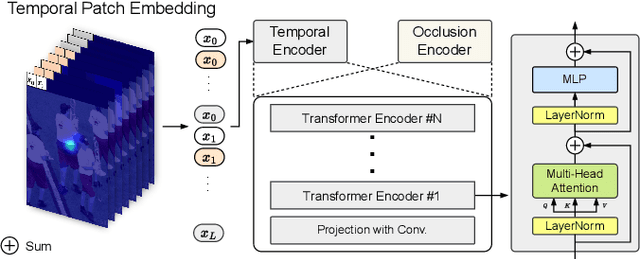Kyung-Min Jin
Kinematic-aware Hierarchical Attention Network for Human Pose Estimation in Videos
Nov 29, 2022



Abstract:Previous video-based human pose estimation methods have shown promising results by leveraging aggregated features of consecutive frames. However, most approaches compromise accuracy to mitigate jitter or do not sufficiently comprehend the temporal aspects of human motion. Furthermore, occlusion increases uncertainty between consecutive frames, which results in unsmooth results. To address these issues, we design an architecture that exploits the keypoint kinematic features with the following components. First, we effectively capture the temporal features by leveraging individual keypoint's velocity and acceleration. Second, the proposed hierarchical transformer encoder aggregates spatio-temporal dependencies and refines the 2D or 3D input pose estimated from existing estimators. Finally, we provide an online cross-supervision between the refined input pose generated from the encoder and the final pose from our decoder to enable joint optimization. We demonstrate comprehensive results and validate the effectiveness of our model in various tasks: 2D pose estimation, 3D pose estimation, body mesh recovery, and sparsely annotated multi-human pose estimation. Our code is available at https://github.com/KyungMinJin/HANet.
OTPose: Occlusion-Aware Transformer for Pose Estimation in Sparsely-Labeled Videos
Jul 28, 2022



Abstract:Although many approaches for multi-human pose estimation in videos have shown profound results, they require densely annotated data which entails excessive man labor. Furthermore, there exists occlusion and motion blur that inevitably lead to poor estimation performance. To address these problems, we propose a method that leverages an attention mask for occluded joints and encodes temporal dependency between frames using transformers. First, our framework composes different combinations of sparsely annotated frames that denote the track of the overall joint movement. We propose an occlusion attention mask from these combinations that enable encoding occlusion-aware heatmaps as a semi-supervised task. Second, the proposed temporal encoder employs transformer architecture to effectively aggregate the temporal relationship and keypoint-wise attention from each time step and accurately refines the target frame's final pose estimation. We achieve state-of-the-art pose estimation results for PoseTrack2017 and PoseTrack2018 datasets and demonstrate the robustness of our approach to occlusion and motion blur in sparsely annotated video data.
 Add to Chrome
Add to Chrome Add to Firefox
Add to Firefox Add to Edge
Add to Edge